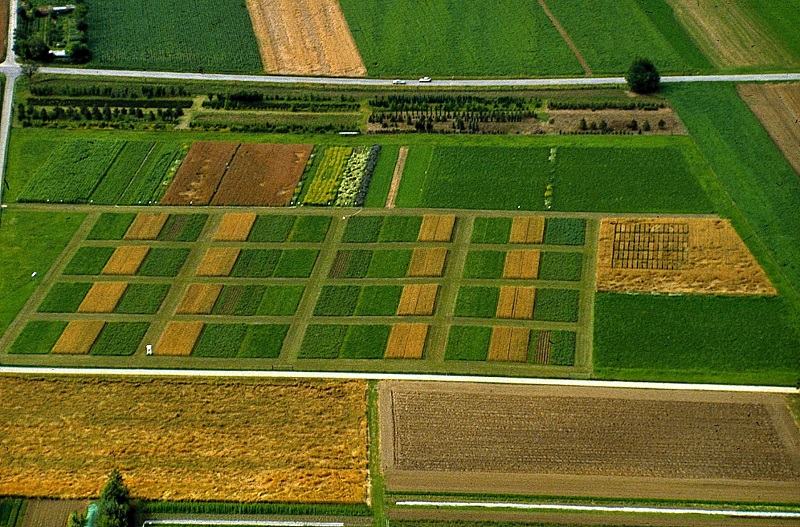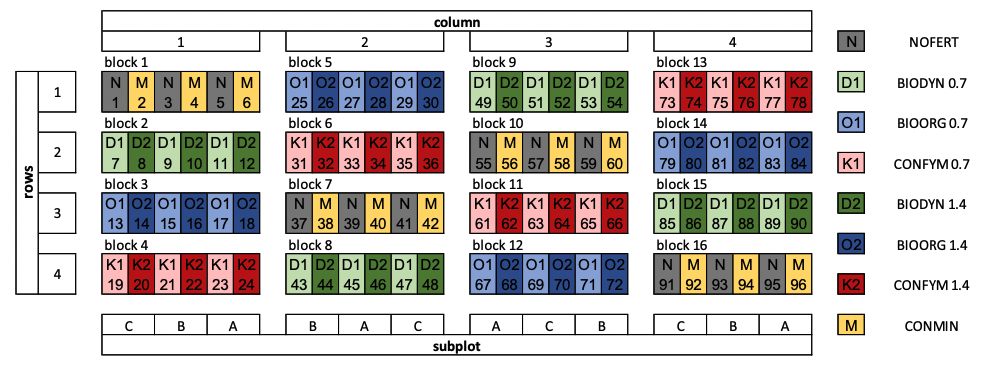What is the DOK trial?
The DOK trial comes up repeatedly when talking about organic farming. It provides invaluable results, especially for biodynamic agriculture. But what actually makes the DOK trial so unique? What does the experimental set-up look like? Who runs it and what do the results tell us about the agricultural systems studied? These questions will be answered in the following overview article.
Figure 1: Aerial view of the DOK trial in Therwil, Switzerland. Photo: FiBL.
What is the DOK trial?
The abbreviation DOK stands for Dynamic, Organic, Conventional (“Konventionell” in German). “Dynamic” refers to biodynamic agriculture, “Organic” to organic farming and “Conventional” to the type of agriculture that emerged from the Green Revolution in the 1960s and rapidly produced high yields through the use of synthetic fertilisers and pesticides.
The DOK trial was established in 1978. It is coordinated by FiBL (Research Institute of Organic Agriculture) and Agroscope, together with several national and international project partners. The DOK trial plots are located in the Leimental near Basel, Switzerland.
What makes the DOK trial so special?
After converting an agricultural system, for example from conventional to biodynamic or organic, various effects only become visible over longer periods of time. One of the reasons for this is that transformation processes in the soil, such as the build-up of stable organic matter, only take place slowly. A long-term comparative study such as the DOK trial, which has been running for over 45 years, is therefore invaluable for comparing agricultural systems with one another.
How is the DOK trial set up?
Figure 2: Spatial structure of the DOK trial. Graphic taken from H.-M. Krause et al., 2022.
The DOK trial consists of 96 plots each of 100 m2. Blocks are formed of six plots. Each of the total of 16 blocks has four replicates. The four different blocks are therefore repeated over the entire trial field. The repetitions are essential to take account of variations in soil composition and chemistry and to obtain more meaningful results. Three different plant varieties are grown in each block, which are rotated annually as part of a seven-year crop rotation.
Each block contains two different treatments:
- Block 1: Unfertilised control (NOFERT) and cultivation with mineral fertilisers in customary quantities according to the recommendations of the research institutes (CONMIN).
- Block 2: Biodynamic cultivation at fertiliser levels 0.7 LSU (BIODYN 0.7) and 1.4 LSU (BIODYN 1.4).
- Block 3: Organic farming with fertiliser levels of 0.7 LSU (BIOORG 0.7) and 1.4 LSU (BIOORG 1.4).
- Block 4: Cultivation with farmyard manure in the fertiliser levels 0.7 LSU (CONFYM 0.7) and 1.4 LSU (CONFYM 1.4).
The abbreviation LSU stands for livestock unit and refers to an animal’s annual nutrient excretion. An adult cow counts as 1.0 LSU, a pig about 0.55 LSU and a laying hen about 0.01 LSU, depending on their age and the exact function of the animals. The fertiliser level of 1.4 LSU per hectare is considered standard practice.
How do the individual DOK plots differ?
The choice of crop variety, crop rotation and soil cultivation are the same for all plots. The primary differences relate to the type and quantity of fertiliser applied and the plant protection measures.
BIODYN is fertilised with slurry and composted farmyard manure (dung), while BIOORG receives slurry and rotted farmyard manure. CONFYM receives mineral fertiliser and rotted farmyard manure. CONMIN uses mineral fertiliser only.
In both organic systems weed control is exclusively mechanical. Only organic preparations are used for pest control. In BIODYN, biodynamic preparations are used in addition. In CONMIN and CONFYM, weed control is carried out chemically and conventional pesticides are also authorised for pest control.
What are the results of the DOK trial?
Scientific studies on the DOK trial are being conducted and published on an ongoing basis. Some of these have already been analysed as study reports by the Section for Agriculture (see further links).
In general, it can be said that BIODYN and BIOORG have a lower yield than CONMIN and CONFYM, but also require a much lower use of fertilisers and pesticides. The energy input (e.g. energy needed by tractors, energy usage for fertilizer production) is lower as well. Moreover, the biodynamic system not only has the least harmful effect on the climate, but also shows the highest soil quality in a number of parameters.
Correction from 30.04.2024
Paul Mäder, Head of the Department of Soil Science at FiBL and contact partner for the DOK trial, has kindly pointed out a few errors in this article. Based on his input, the information on the DOK trial setup has been revised.
Sources and further links to this article
- FiBL project website for the DOK trial
- Conversion of livestock units of the Canton of Zurich (German)
- Illustration of the experimental setup of the DOK experiment taken from:
- Krause, H.-M., Stehle, B., Mayer, J., Mayer, M., Steffens, M., Mäder, P., Fliessbach, A. Biological soil quality and soil organic carbon change in biodynamic, organic, and conventional farming systems after 42 years. Agronomy for Sustainable Development (2022) 42:117. https://doi.org/10.1007/s13593-022-00843-y
- Cover picture taken from:
Study reports on the DOK trial

